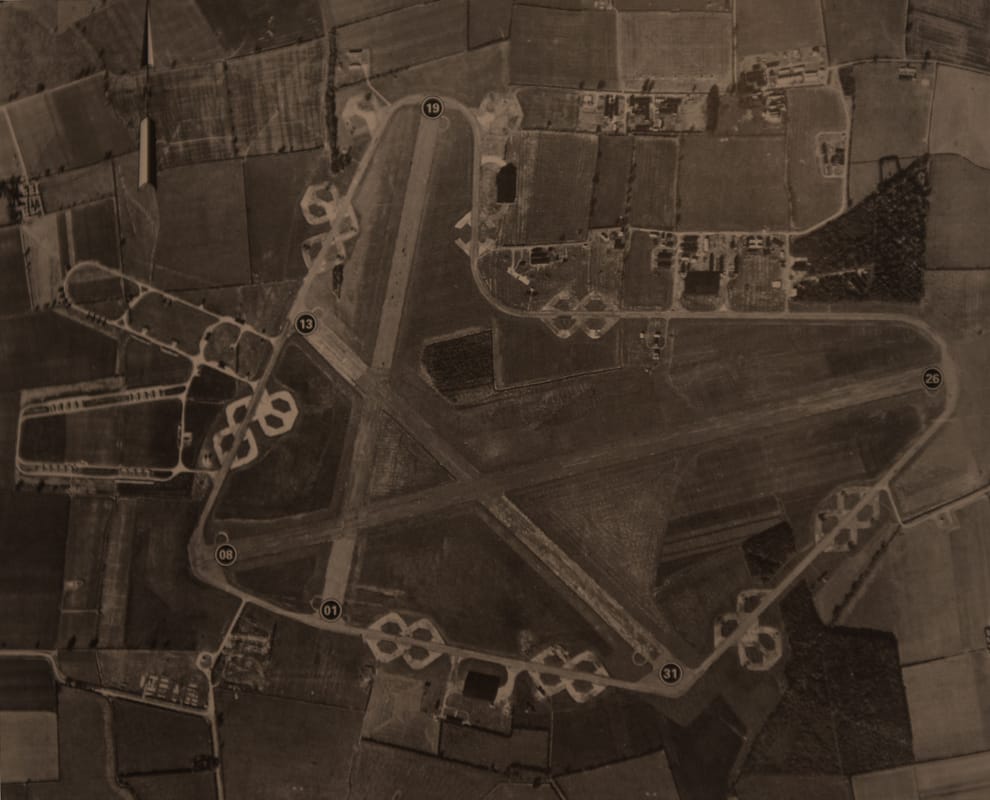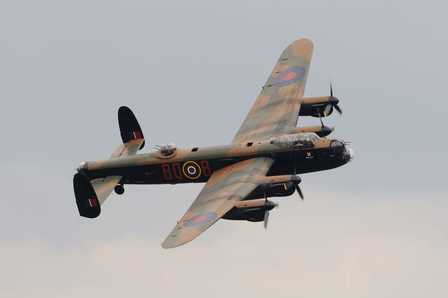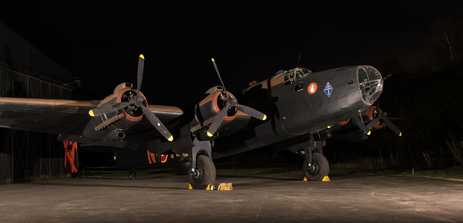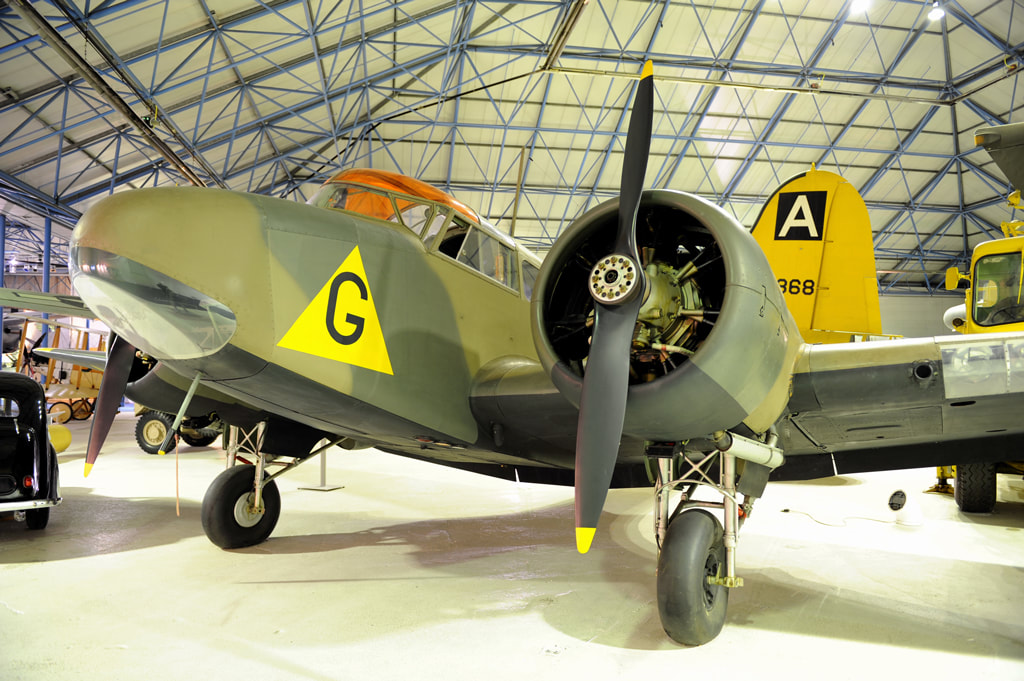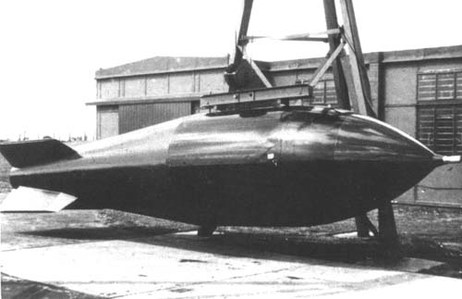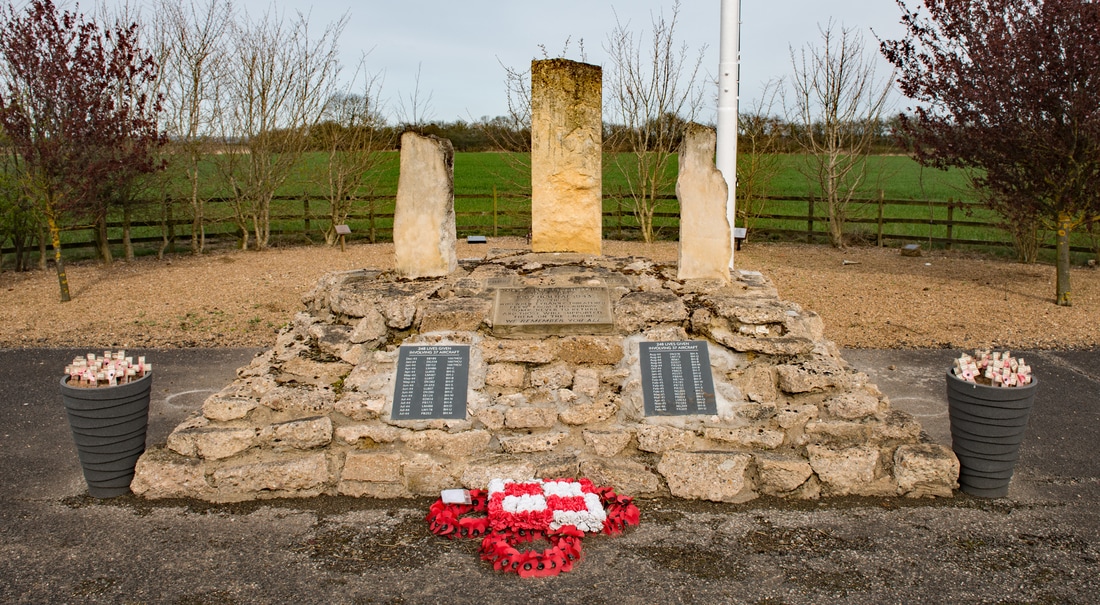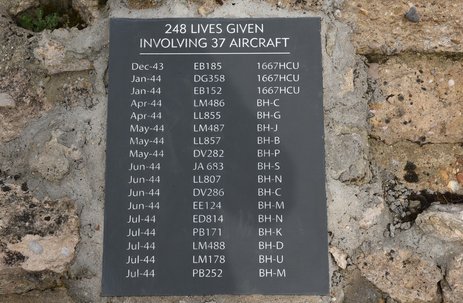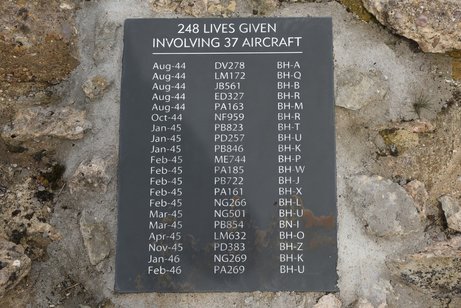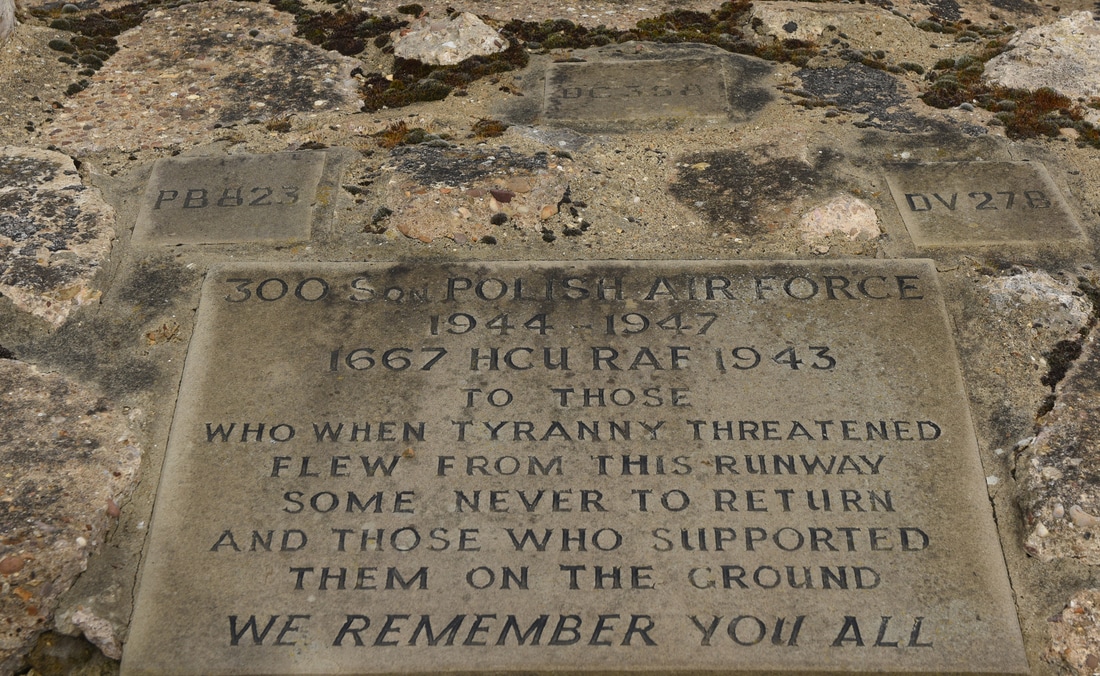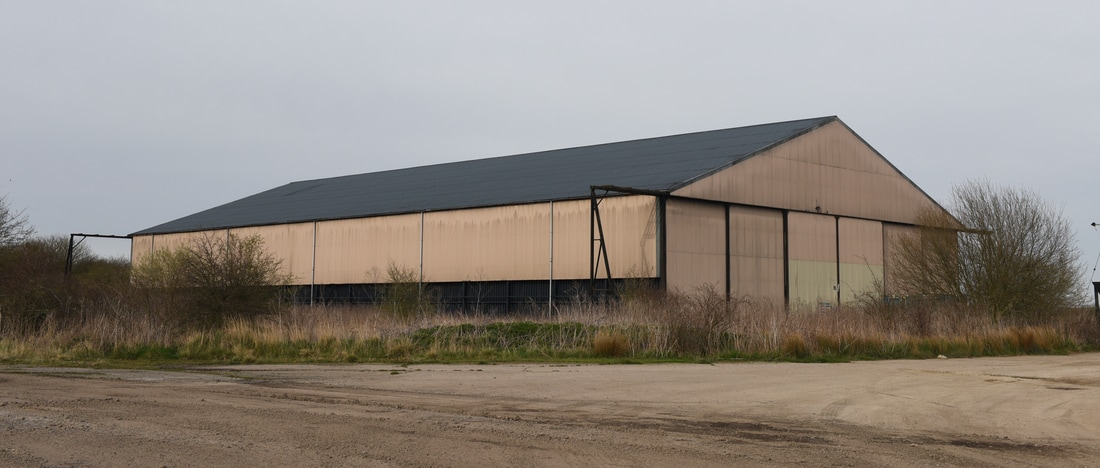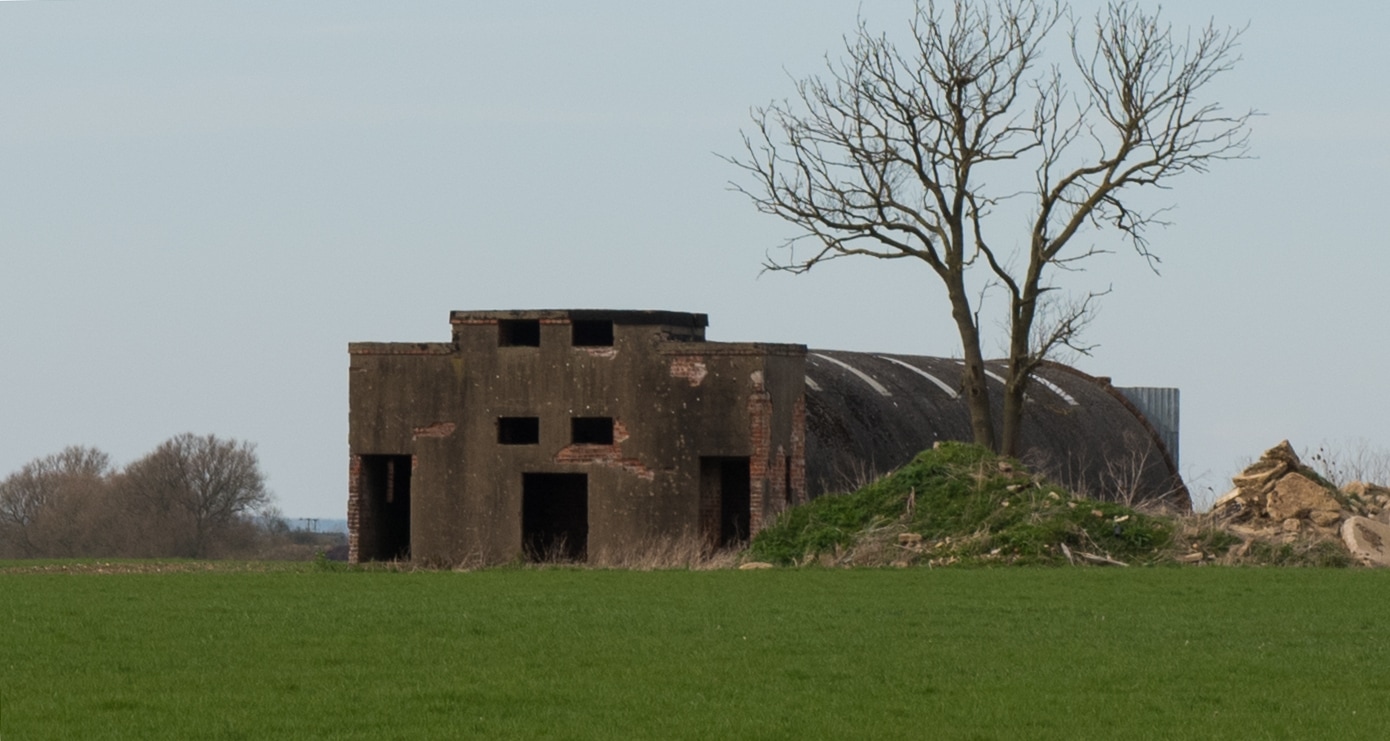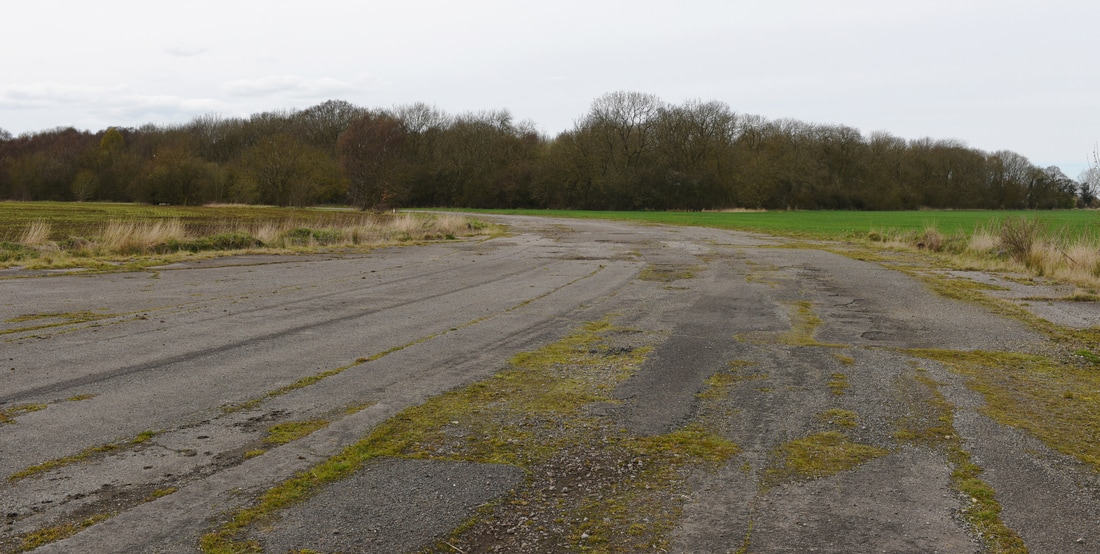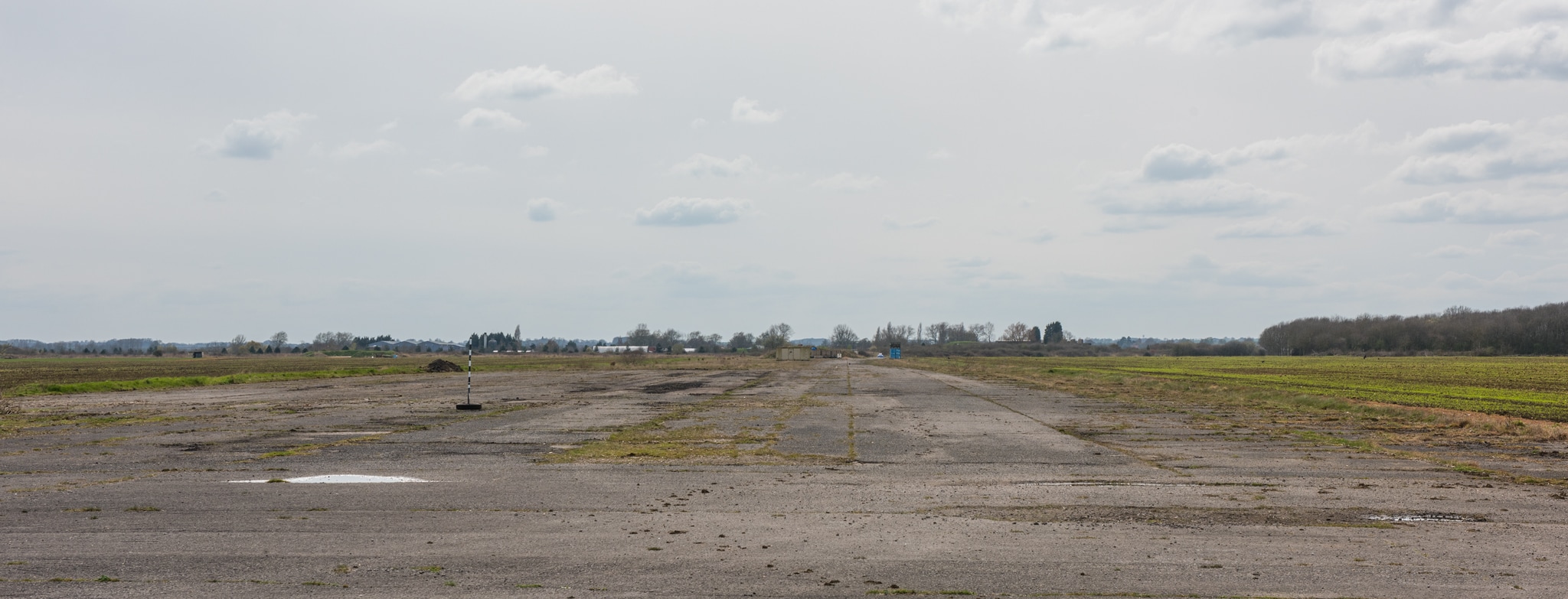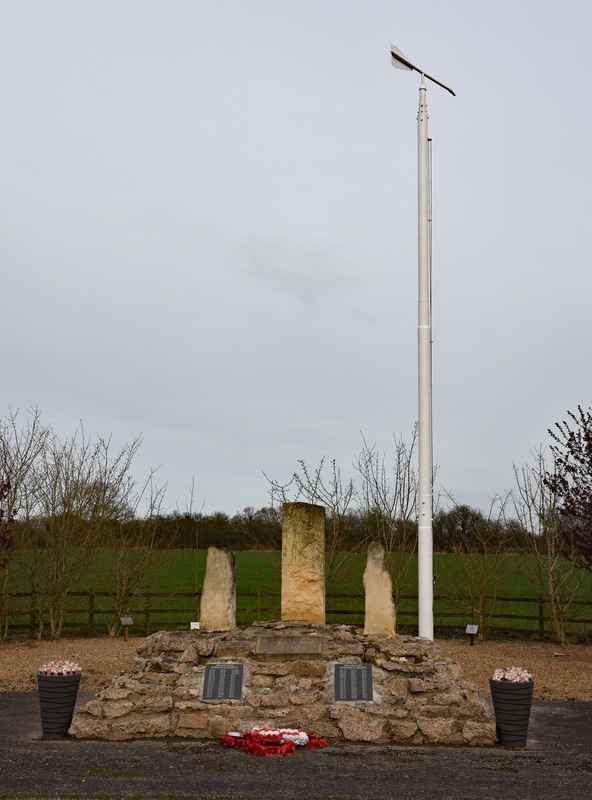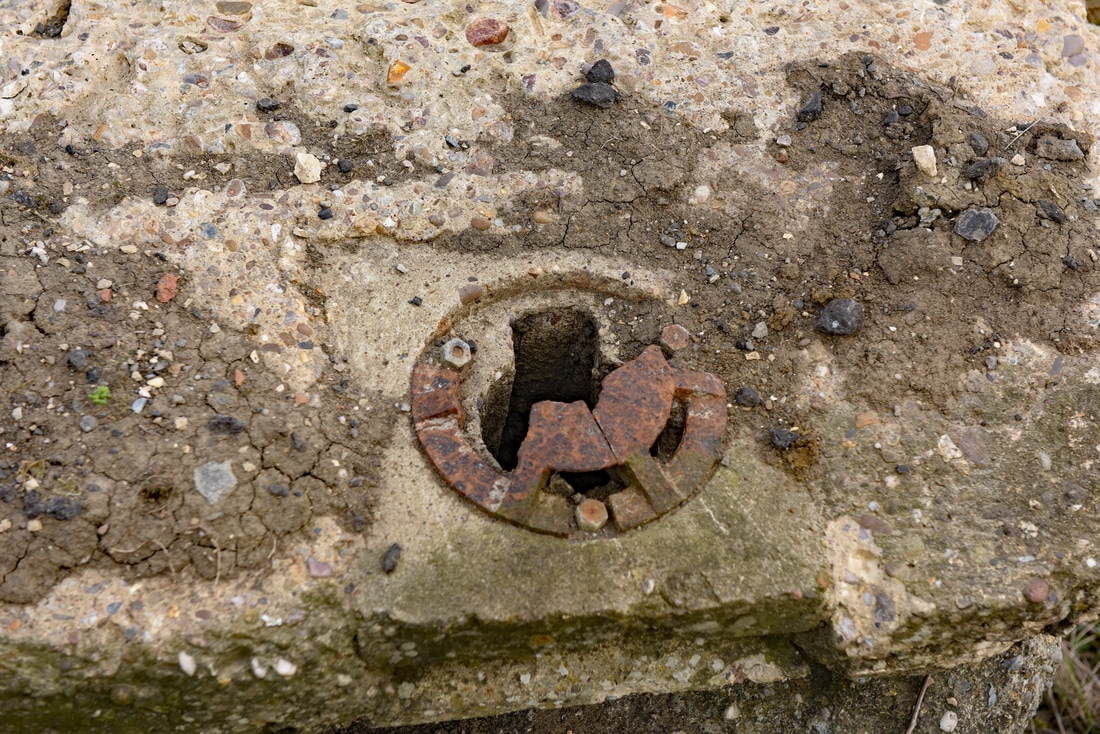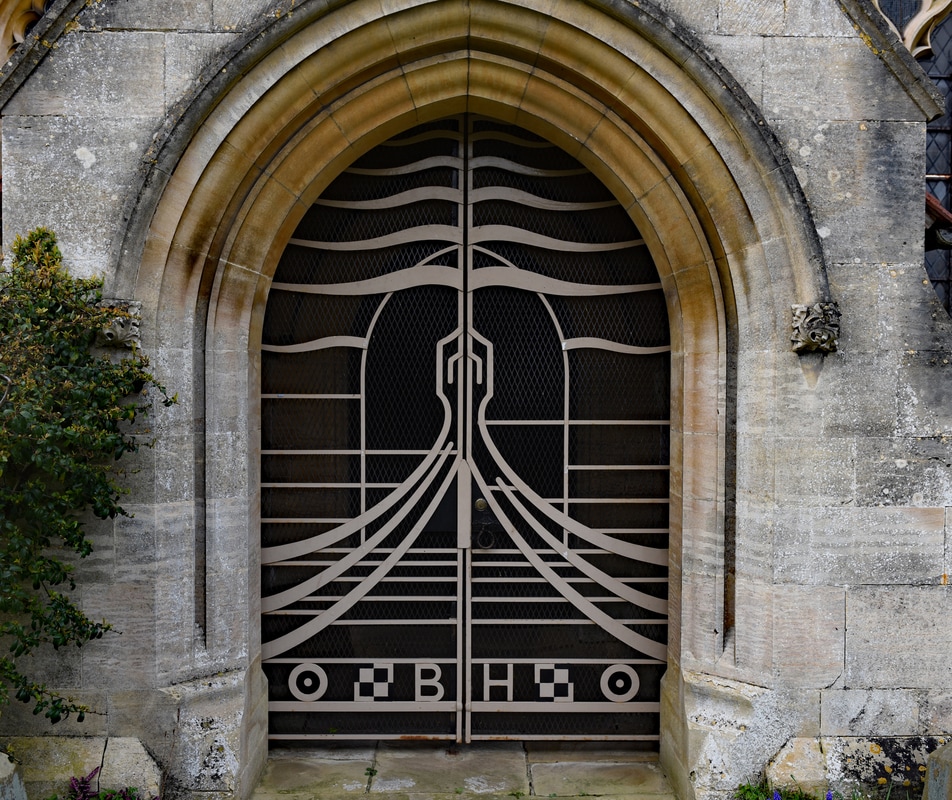RAF Faldingworth
Written By Richard Hall
RAF Faldingworth was located four and a half miles from Market Rasen to the southeast of the River Ancholme. Originally, the proposed airfield site was used as a decoy airfield known as Toft Grange for RAF Hemswell, with mock-ups of Whitley bombers scattered around the field.
|
In July 1942, the contractors Tarmac Ltd and J Cryer & Sons commenced construction of a Class A airfield at Faldingworth. Three runways were laid 08-26 at 2,000 yards, 01-19 and 13-31 at 1,400 yards.
Thirty-six hardstandings were connected to the perimeter track with hangars provided in the form of two T2s and one B1. Domestic, communal, mess and sick quarter sites were dispersed to the northeast near Newton by Toft, with accommodation provided for 1,957 males and 281 females. |
Faldingworth was allocated to 1 Group and acted as a satellite to RAF Lindholme in South Yorkshire. In 1943 with the Allied bombing campaign in full swing both by day with the USAAF 8th Air Force and by night with Bomber Command, the need for crews to replace operational losses was paramount. The task within Bomber Command to train fell upon the Operational Training Units (OTU) and later Heavy Conversion Units (HCU). These units were usually equipped with war-weary aircraft, which certainly did not make the task for crews any easier with the added factor of aircraft reliability to concern themselves.
No 1667 Heavy Conversion Unit
|
August 1943 saw the first unit to arrive at Faldingworth in the form of 1667 Heavy Conversion Unit (HCU), which flew in from their former home RAF Lindholme. Aircraft on strength at the time was Avro Lancasters and Handley Page Halifax. However, conversion onto four-engine heavy bombers was never an easy task, and the first loss at the airfield occurred on 30 September 1943. Lancaster B.I R5685 lost power from its port outer engine and crashed whilst trying to land a mile to the east of the duty runway. There was one fatality, Flt Sgt T D Crossland of the Royal Canadian Air Force.
|
A far more serious accident occurred on 16 December 1943 when Halifax V EB185 crashed at 23.25hrs during a night exercise one mile northeast of the airfield. All seven of the crew perished as a result of the crash.
|
The Lancasters time at Faldingworth with 1667 HCU was coming to an end as a decision was taken to concentrate all Lancaster training for 1 Group within one unit.
The Lancaster flight of 1667 HCU was renamed 'C' Flight of 1 Lancaster Finishing School and departed to RAF Hemswell. This left Faldingworth as an all Halifax airfield. |
1667 HCU's time at Faldingworth was short, but one further serious accident was to occur before the unit's departure. On 23 January 1944, Halifax V DG358 took off from the airfield at approximately 14.40 hrs for a high-level cross country training flight. While flying at 20,000ft, the bomber's starboard outer engine failed, forcing the aircraft to lose height. Descending into thick storm clouds, the Halifax quickly iced up, which caused it to go out of control. The machines starboard wing became detached, which sealed the aircraft's fate and its crew. Coming to ground at Cwm Farm, Bryn y Groes, Bwlch y Fridd in Wales with the loss of all nine on-board. By the end of February 1944, 1667, HCU had moved out to RAF Sandtoft, and Faldingworth became part of 14 Base under the control of RAF Ludford Magna.
After the invasion by Nazi Germany, many personnel fled their countries to seek refuge in Great Britain, where some continued the fight against their invaders. One such group were Polish airmen who formed squadrons within the RAF, both with Fighter and Bomber Command.
|
On 1 March 1944, 300 (Mazowiecki) Squadron flew in from RAF Ingham equipped with Vickers Wellington bombers. The Squadron undertook its first mission from Faldingworth on 3/4 March 1944, when three Wellingtons flew on a mine laying operation to the approaches of the U-Boat base at Lorient.
|
This operation was to be the last undertaken by Bomber Command Wellingtons, and all aircraft returned safely. However, the type did continue for a time as Radio Countermeasures aircraft and with OTUs within Bomber Command.
At the time of 300 Squadron's arrival at Faldingworth, the unit was in the process of converting to Avro Lancasters. The first operation for the newly converted squadron was to Rouen on 18/19 April 1944 to bomb railway yards. Bomber Commands focus now was support of the upcoming invasion of Europe. Consequently, the disruption of the French railway system was a high priority to delay German troop and equipment movements. Two hundred and seventy aircraft took part in this raid, with all returning safely.
The first operational losses for 300 Squadron while flying from Faldingworth occurred on 24/25 April 1944, when Lancaster I LL855 BH-G and Lancaster III LM486 BH-C failed to return from a raid on Karlsruhe, with the loss of all crew.
It was not always enemy action that caused losses. On 22/23 May 1944, Lancaster I LL857 BH-B took off at 22.40hrs for an operation to Dortmund. The aircraft was obliged to turn back following engine trouble and jettisoned part of its bomb load over the sea. As the Lancaster approached Faldingworth's runway, it collided with the airfield's gunnery butts. Two crew members were killed instantly, with six others being pulled from the wrecked aircraft, one of whom died of his injuries a few hours later.
At the time of 300 Squadron's arrival at Faldingworth, the unit was in the process of converting to Avro Lancasters. The first operation for the newly converted squadron was to Rouen on 18/19 April 1944 to bomb railway yards. Bomber Commands focus now was support of the upcoming invasion of Europe. Consequently, the disruption of the French railway system was a high priority to delay German troop and equipment movements. Two hundred and seventy aircraft took part in this raid, with all returning safely.
The first operational losses for 300 Squadron while flying from Faldingworth occurred on 24/25 April 1944, when Lancaster I LL855 BH-G and Lancaster III LM486 BH-C failed to return from a raid on Karlsruhe, with the loss of all crew.
It was not always enemy action that caused losses. On 22/23 May 1944, Lancaster I LL857 BH-B took off at 22.40hrs for an operation to Dortmund. The aircraft was obliged to turn back following engine trouble and jettisoned part of its bomb load over the sea. As the Lancaster approached Faldingworth's runway, it collided with the airfield's gunnery butts. Two crew members were killed instantly, with six others being pulled from the wrecked aircraft, one of whom died of his injuries a few hours later.
1546 Beam Approach Training Flight
|
In May 1944, another unit joined the Poles at Faldingworth. Equipped with eight Airspeed Oxfords, 1546 Beam Approach Training Flight was formed.
The Beam Approach system consisted of two radio transmissions originating from the same point, which with the aid of aerials, produced elongated lobes. By overlapping the lodes, a beam was created that could be aligned along a single bearing, commonly the runway centreline. |
One lode would transmit a continuous 'N' in morse whilst the other an 'A'. The space in between where the lodes overlapped produced a continuous tone. A pilot, when on course for the runway centreline, would hear this continuous tone and, if he deviated from the course, would hear an N or A. Learning to fly while hearing the continuous tone was a vital skill to be mastered by pilots as it allowed them to land in at night and in times of poor visibility, something very often experienced at bomber airfields. The Flight remained at Faldingworth until its disbandment in January 1945.
Squadron Expansion
In June 1944, a second flight for 300 Squadron was formed, but there was a shortage of Polish crews, necessitating the use of personnel of other nationalities to equip the flight until additional Polish personnel became available.
Bomber Command well recognised the bravery and determination of the Polish crews, and they went on to fly in the main offensive until the end of operations. The final raid for 300 Squadron was on Berchtesgaden on 25 April 1945. The last task for the squadron of the war was in support of Operation Manna on 7 May 1945, where supplies were dropped to starving Dutch civilians.
Although 300 Squadron was the only operational unit at Faldingworth in the war, C Flight of 166 Squadron formed at the airfield with Lancasters in October 1944, before moving to RAF Kirmington. During their time at Faldingworth, 300 Squadron flew on 138 operations, which equalled 1,216 sorties, in the process losing 30 aircraft, a 2.5% loss rate.
The squadron continued to operate from Faldingworth post-war and took part in Operation Dodge (repatriation of Allied POWs in Italy and Mediterranean) and Operation Exodus (repatriation of Allied POWs in Europe). The squadron finally disbanded in October 1946.
Later in October 305 (Ziemia Wielkopolska) Squadron flew its De Havilland Mosquitos IVs into Faldingworth from Germany. No 305 was disbanded at the airfield in January 1945, effectively spelling the end of flying at Faldingworth. The station was then placed under Care and Maintenance parented from RAF Hemswell.
Bomber Command well recognised the bravery and determination of the Polish crews, and they went on to fly in the main offensive until the end of operations. The final raid for 300 Squadron was on Berchtesgaden on 25 April 1945. The last task for the squadron of the war was in support of Operation Manna on 7 May 1945, where supplies were dropped to starving Dutch civilians.
Although 300 Squadron was the only operational unit at Faldingworth in the war, C Flight of 166 Squadron formed at the airfield with Lancasters in October 1944, before moving to RAF Kirmington. During their time at Faldingworth, 300 Squadron flew on 138 operations, which equalled 1,216 sorties, in the process losing 30 aircraft, a 2.5% loss rate.
The squadron continued to operate from Faldingworth post-war and took part in Operation Dodge (repatriation of Allied POWs in Italy and Mediterranean) and Operation Exodus (repatriation of Allied POWs in Europe). The squadron finally disbanded in October 1946.
Later in October 305 (Ziemia Wielkopolska) Squadron flew its De Havilland Mosquitos IVs into Faldingworth from Germany. No 305 was disbanded at the airfield in January 1945, effectively spelling the end of flying at Faldingworth. The station was then placed under Care and Maintenance parented from RAF Hemswell.
Post War Use
|
In April 1949, Faldingworth transferred from Bomber Command to 42 Group Maintenance Command as a subsite for 93 Maintenance Unit, which remained in control until 1957.
With the start of the new decade in the early 1950s, Faldingworth was selected as a site for the storage and maintenance of nuclear weapons, particularly Blue Danube, which was Britain's first atomic weapon, used by Avro Vulcans from nearby RAF Scampton and Waddington. |
The site came under the control of 92 Maintenance Unit and was completed by 1957. With the storage of nuclear weapons, Faldingworth required a much more robust security regime. Watch towers were constructed, and layers of fencing, both mesh and concrete topped with barbed wire, greeted any potential trespassers. The inner facility compound was accessed through electrically operated gates, with this area protected by free-roaming guard dogs.
In 1969 free-fall nuclear weapons were withdrawn from active service, and the RAF's use for Faldingworth ended with it closing in 1972.
Subsequently, Faldingworth was acquired by The British Manufacture and Research Company and Oerlikon (later owned by Royal Ordnance), who used the site as a test and production facility. In addition, Royal Ordnance used the site for armament storage and experimentation until putting it up for sale in 1996.
RAF Faldingworth was mostly sold off for agriculture in 1998, but some of the site remains in use as a firing range, explosive testing facility, research and development and film work.
In 1969 free-fall nuclear weapons were withdrawn from active service, and the RAF's use for Faldingworth ended with it closing in 1972.
Subsequently, Faldingworth was acquired by The British Manufacture and Research Company and Oerlikon (later owned by Royal Ordnance), who used the site as a test and production facility. In addition, Royal Ordnance used the site for armament storage and experimentation until putting it up for sale in 1996.
RAF Faldingworth was mostly sold off for agriculture in 1998, but some of the site remains in use as a firing range, explosive testing facility, research and development and film work.
Memorial
All images - Richard Hall
The memorial located at the head of runway 08/26 is dedicated to 1667 HCU and 300 Squadron.
All images - Richard Hall
The memorial located at the head of runway 08/26 is dedicated to 1667 HCU and 300 Squadron.
The memorial is constructed from pieces of concrete from the runways, perimeter track and buildings. Within the base of the memorial small parts of aircraft lost from Faldingworth have been placed. In addition, pieces from Polish crewed aircraft have been buried in soil from Masovia, Poland. Three columns of stone rise from the memorial base, which represent Lincoln Cathedral, a landmark very familiar to Bomber Command crews. Located behind the memorial is Faldingworth's old windsock post.
The Airfield Today
Below shows some of what is now left at RAF Faldingworth (2016).
Below shows some of what is now left at RAF Faldingworth (2016).
All Saints Church Faldingworth - Memorial Porch Gates
300 Squadron's code letters of BH have been incorporated into the design of the gates.
300 Squadron's code letters of BH have been incorporated into the design of the gates.
Sources
- Airfields Of Lincolnshire Since 1912 - Ron Blake - Mike Hodgson - Bill Taylor
- Bomber Command Airfields Of Lincolnshire - Peter Jacobs
- Bases Of Bomber Command Then And Now - Roger A Freeman
- The Source Book Of The RAF - Ken Delve
- Royal Air Force Bomber Command Losses Of The Second World War 1943, 1944 & 1945 - W R Chorley
- www.subbrit.org.uk
- polishsquadronsremembered.com
